#runestones
Text
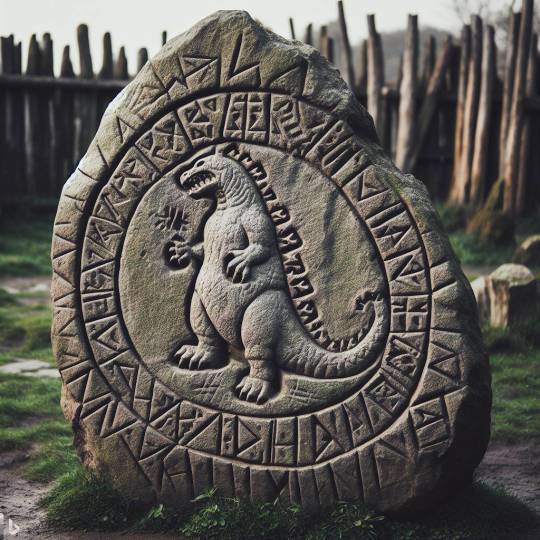
The Vikings were not unaware of Godzilla, as can be seen by this rune stone.
194 notes
·
View notes
Text


The Ramsund carving, believed to have been carved around 1030, was found close to Ramsund, Sweden. It is considered part of the “Sigurd stones”, a group of eight or nine runic inscriptions which can be found in Sweden, with all pertaining to the myth of the hero Sigurðr. The Ramsund stone depicts scenes from the Völsunga Saga, which go as follows:
Sigurðr preparing a fire to roast the dragon Fáfnir’s heart, as instructed by his uncle Regin. Having burnt himself in the process, Sigurðr sticks his finger in his mouth. He is soon to discover that the dragon’s blood which stained his finger gave him the ability to understand the language of birds as they sang.
The birds warn Sigurðr that Regin intends to kill him and take the dragon Fáfnir’s treasure for himself.
This prompts Sigurðr to end the life of his treacherous uncle, whose body now lies next to his smithing tools.
Sigurðr’s horse Grani now carries the dragon’s treasure.
Depiction of Sigurðr killing Fáfnir: having concealed himself in a hole outside the dragon’s lair, he waited for it to crawl outside and towards the river to go and drink so he could stab upwards into the beast’s heart.
Depiction of the three brothers, Regin, Fáfnir (whose greed turned him into a dragon), and Ótr, who appears along with his brethren at the beginning of the saga.
#heathenry#sagas#runestones#norse paganism#spirituality#norse myths#mythology#myths#paganism#polytheism#runes
218 notes
·
View notes
Text
got a new runestone in the works for @battlebabebeulah.

still drafting the sketch, but it’s almost time to start carving. each numbered section will have a stanza of a poem in it
and here’s the slab i’ll be working with

120 notes
·
View notes
Text


Giant Viking Runestone Found Under kitchen Floor in Denmark
A Couple Renovating Their Kitchen in Denmark Found an Ancient Stone Carved With Viking Runes
The stone may be one of the oldest and rarest of its kind, and is now being studied by experts.
When Lene Brandt and her husband, Anders Nielsen, were preparing to tear up the linoleum floors in the kitchen in their home in the village of Mosekær, in Denmark, they probably expected the normal things that occur in the course of such a project: cost overruns, delays, and problems with contractors.

Instead, what they found was an ancient artifact. The couple stumbled across a nearly 2,000-pound stone, measuring more than six feet long, carved with ancient runes. The couple contacted local experts at the Museum Østjylland. Staff archaeologist Benita Clemmensen is quoted by the cultural news site Skjalden saying that these stones are the sole written records of the Viking Age.
Five runes can be found carved into the stone’s surface, reading “aft Bi,” which can be translated as “after B.”

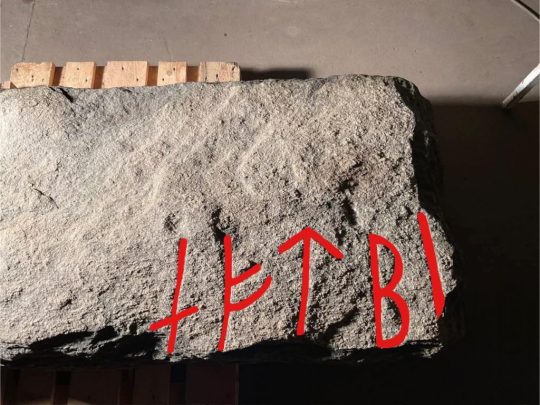
“The Mosekær stone is probably to be dated to the eighth or nineth century because of the formula ‘After… ‘, i.e. ‘In memory of’, placed in the beginning of the text,” senior researcher and runologist Lisbeth Imer, with the National Museum of Denmark, Copenhagen, tells Artnet News. “It correlates with an eighth-century runestone on Fyn, the Flemløse stone with the text ‘After Hróðulfr stands this stone; he was… priest/chief. Sons placed in memory. Ávarr coloured.’
“It most likely is one of the oldest runestones in Denmark,” she says.
The museum has dubbed the stone a treasure, meaning it legally belongs to the state.
New rune stones are found only every five or 10 years, Imer says, “so it is a rare find.”
Imer tells Skjalden that only about 20 rune stones from the eighth century have been discovered in Denmark. These early stones are very significant, as there are approximately 200 known Viking Age rune stones (dating from the 700s to the 900s) throughout the country. Norse literature is dense with references to runes, which may have served as magical signs to be used in charms.
The area where this rune stone was found has proven particularly rich for archaeologists, yielding some 44 such artifacts.

#Giant Viking Runestone Found Under kitchen Floor in Denmark#vikings#runestones#ancient artifact#archeology#archeolgst#history#history news#ancient history#ancient culture#ancient civilizations#viking age#viking history
252 notes
·
View notes
Photo
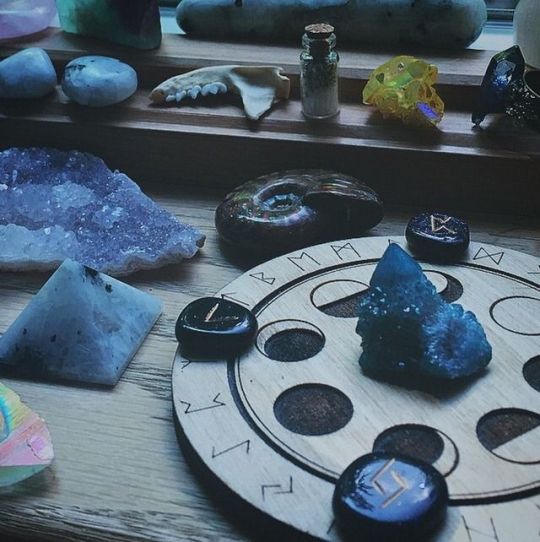
🔮 Witchy Goth & Pagan Shop 🔮
#witch#witchcraft#occult#pagan#paganism#runestones#divination#psychic#crystal witch#baby witch#beginner witch#tarot cards#tarot#green witch
704 notes
·
View notes
Text

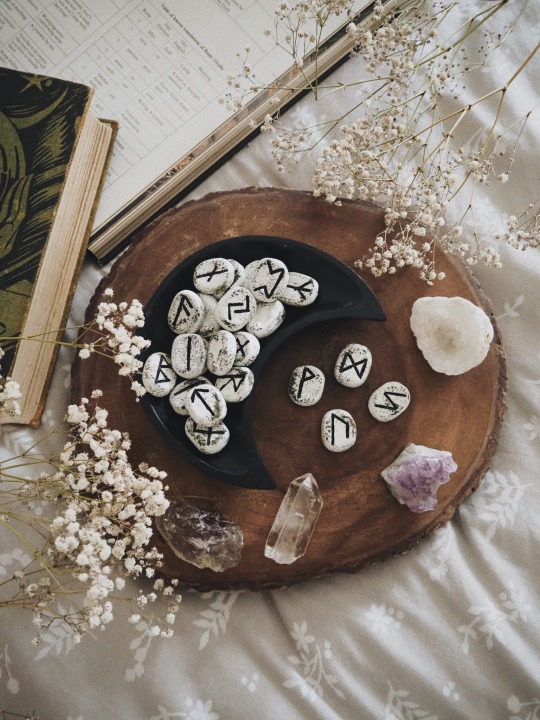
I feel like I’m getting better at this whole making rune stones malarkey 🤎
#the forest ivy#runestones#rune stones#pagan#paganism#norse mythology#norse paganism#witches of tumblr#crystal#crystals#divination#dark cottagecore#slow living#handmade#oh fauna#witchblr
139 notes
·
View notes
Text
Using cutting-edge technology, archaeologists have finally identified who carved the infamous 1,000-year-old Jelling Stones.
27 notes
·
View notes
Text

Standing Tall
#mine#portfolio#photography#sky#photographers on tumblr#photo mode#ubisoft#games#video games#xbox one#in game photography#assassins creed#myfavegames#assassins creed valhalla#valhalla#stones#standing stones#runestones#viking#night#askefroagaming#statues#peaceful#runes#norse mythology#virtual photography
61 notes
·
View notes
Text

Set of 25 Ceramic Elder Futhark Runestones
10 notes
·
View notes
Photo
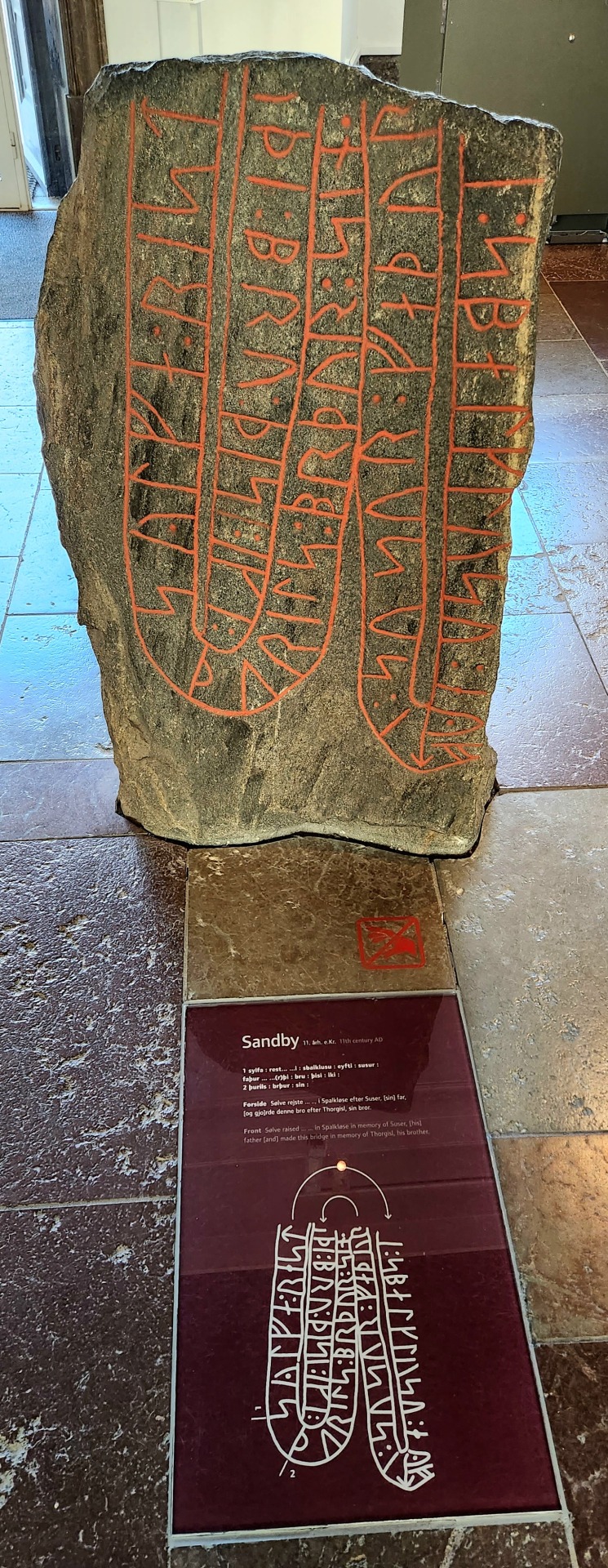
Sandby Runestone
Solve raised... in Spalklose in memory of Suser, [his] father [and] made this bridge in memory of Thorgisl, his brother
11th century AD
- Danish History Museum, Copenhagen, Rune Hall
#history#historyblr#runes#runestones#rune stones#rune hall#danish history museum#history museum#museum#museums#danish history#history of denmark#vikings#viking history#viking artefacts#viking artifacts#sandby runestone
43 notes
·
View notes
Text

#own#witchcraft#witch#witches#witchblr#pagan#paganism#paganblr#norse paganism#norse mythology#nordic mythology#nordic paganism#viking mythology#viking runes#nordic runes#norse runes#runes#magic runes#runestones#witch aesthetic#pagan aesthetic#viking aesthetic#witchy aesthetic#heathenry#heathen#norse heathen#norse heathenry#norse witch
33 notes
·
View notes
Text

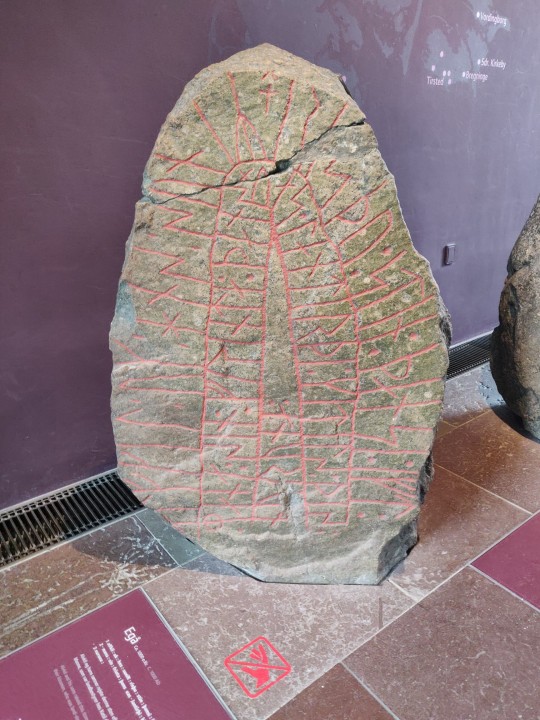

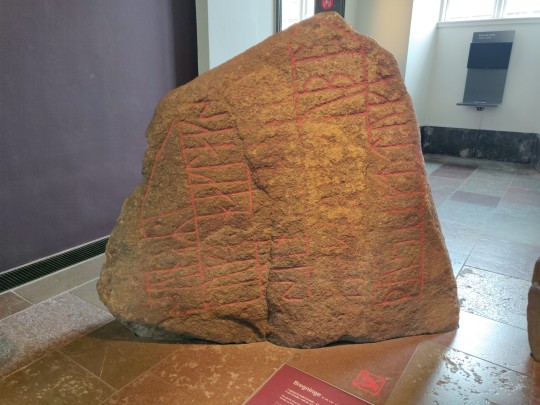




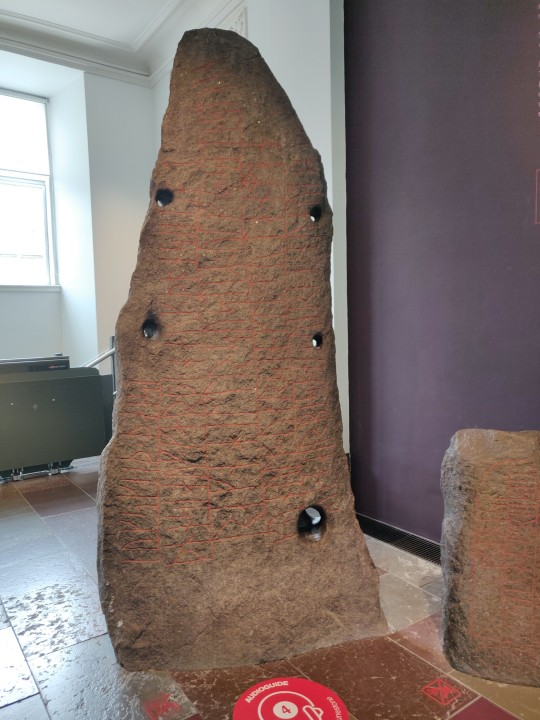
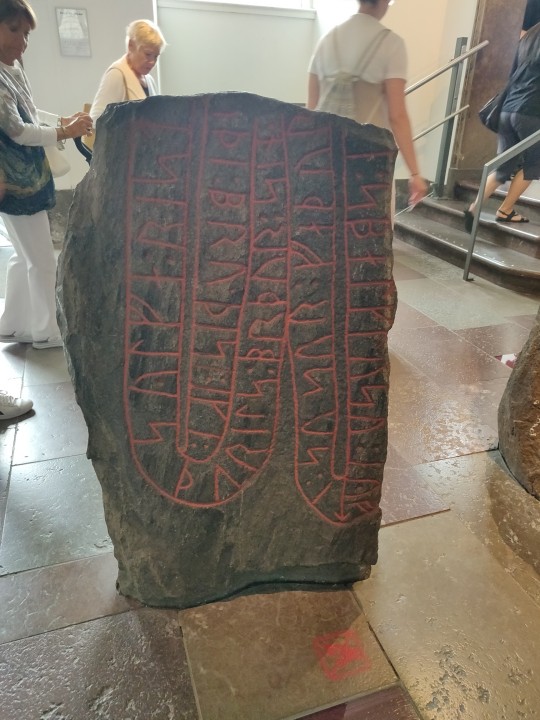
Runestones in the National Museum of Denmark, Copenhagen
#myposts#denmark#norse#runestones#runes#some of then were made after christianisation so i wont tag heathen#reminder that runes are just an alphabet and dont equate religion
24 notes
·
View notes
Text
Lord of the Rings Tarot
my sister gave me the Lord of the Rings tarot by Tomás Hijo. it's such a beautiful deck.
the box is fantastic quality. a lovely two piece box covered in beautiful art that well represents the card inside. it has an insert to hold the deck snuggly and the guide sits on top. the art style of both deck and box uses either linocut or woodcut printing, which is a style that I really love.
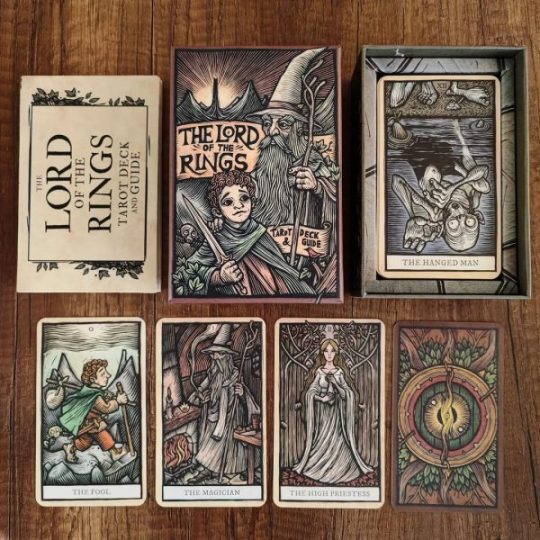
The cards themselves are all beautiful, and the guide to go with it ties the lore from Lord of the Rings into the meaning behind each card so beautiful. The design on each card is printed with care and skill that I, as someone who has done lino cut projects, am amazed by. The artwork truly is stunning.
This is fast becoming my new favourite deck, it's such a pleasure to do readings with. The cards are easy to read and interparate, the guide is succinct. The card are fairly thick and sturdy cardstock and are unlikely to get damaged when used and stored with care, and the same can be said for the box and guide. It is, overall, a high quality deck and I couldn't recommend it more!
#pagan witch#witch#witchcraft#witches#norse paganism#pagan#paganism#tarot#tarot deck#runestones#tarot reading#tarot cards#tarot community#tarot witch#divination#lord of the rings#lotr#lord of the rings tarot
8 notes
·
View notes
Text

mini runestone to help me get back into the swing of things and definitely not because i have homework due in 3 hours
8 notes
·
View notes
Text
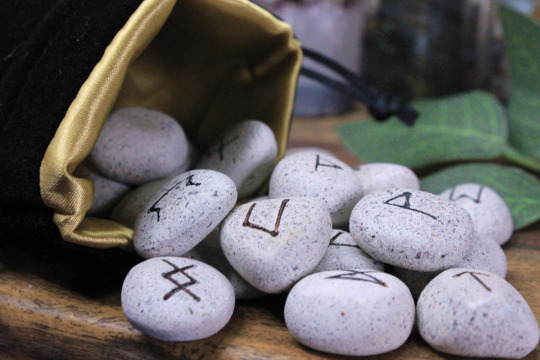
Ceramic runes at sylverra
Link above | $5 flat shipping all US orders | Free US shipping over $50
#runes#rune stones#runestones#rune sets#norse#norse runes#elder futhark#divination#rune casting#runes for sale#runestone#norse witch#norse paganism#crystal shop#shop small
51 notes
·
View notes
Photo
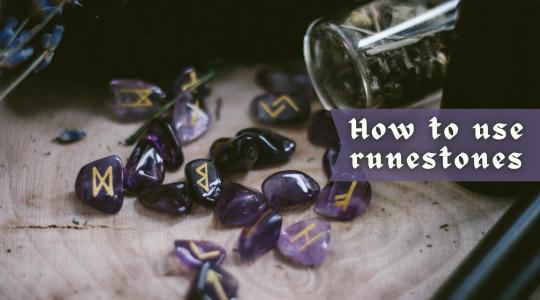
A Complete Guide to Runestones
Casting and reading the runes is a popular form of divination in modern new-age practice. It is based on an old Germanic and Norse practice linked with the practice of Heathenry and the worship of Odin and other northern European pagan gods.
Like many other forms of divination, the practice is designed to help you access your intuition or your spiritual senses to bring to the surface truths that you already know in your heart. Your subconscious mind is much more powerful than your conscious mind and has information you simply cannot take in consciously. Practices such as rune casting let you quiet the conscious mind so that your subconscious mind has space to speak and reveal.
You can read more about the underlying philosophy of divination in our post about using the Tarot.
In this article, we will take you through several methods for casting rune stones for divination and how to interpret the runes. At the end of the article, we will also take a closer look at the history of the runes from ancient times to modern practice.
How to Read the Runes
Since rune casting is all about tapping your intuition and divine spark, there is no single right way to use them. Many experienced rune readers have developed their own approaches and shared them, so look around for ideas and inspiration.
But any approach will involve holding a question in your mind and then casting, placing, or selecting stones that will guide you toward a response.
Before you start, there are a few steps that you should take.
Find a set of runestones that speaks to you spiritually – you can shop our runestone collection here.
Connect with your rune stones by spending time with them. This should be physical, holding them in your hands and examining them, and intellectual, reading your guidebook and taking in the meanings associated with the different runes.
Prepare yourself through meditation that helps you to quiet your active mind and let your subconscious mind flow to the surface.
Learn how to ask questions, which should be open-ended, since all things are possible, rather than yes or no questions.
Read our more detailed guide to preparing for a divination session here.
Before every individual casting, you should also cleanse your rune stones of energy other than your own. You can protect your rune stones by storing them with energy-cleansing crystals such as black obsidian, citrine, or amethyst. You can also cleanse your cards by leaving them under the light of the moon for a night or smudging them with incense. You should then hold the runestones in your hands for several minutes before a reading to make a connection between yourself and the runes.
Casting Patterns and Methods
There are many different ways to then use the runes to find answers, but we will go through some of the simplest and our favorites below.
The Three Norns
Hold your runestones while considering your question, and then retrieve the rune stones that seem right either from your hands or from a sack. Place three runestones in a row in a horizontal line. The first runestone will reveal the major causes of your current challenges. The middle stone will represent the reality of your current situation, which we are often blind to. The final runestone will indicate the best course of action going forward.
The Four Dwarves
This casting works in the same way, except that you will place four runestones in a circle, working clockwise from the top. The top rune indicates the main causal factors of your situation. The runestone on the right suggests that you are doing that is influencing the current situation, while the left indicates what others might be doing or feeling. The bottom runestone indicates the reality of what is happening that is currently hidden from you.
Vé Branches
This is a more complex casting that uses seven runestones laid out in a V shape. Start with the bottom rune and work upwards, placing runes on the right and then the left. The rune at the bottom represents the truth of your current situation, and each line represents one of the most likely outcomes. The first rune represents your most likely action, the second your motivation for that action, and the third what the result is likely to be.
Rune Board
Other casters use a rune board. This can be designed in various ways but will have different areas that relate to different elements. It could be past-present-future, cause-affect-outcome, or different aspects of your personality. In this case, when you are ready to ask your question, you throw the runes over the board and make your reading based on where they land.
Individual Rune Meanings
There are many different rune designs, and each will come with its own guide with different meanings and interpretations. Also, as you become accustomed to the runes and grow close to them, you will start to develop your own meanings and associations.
Nevertheless, below are the most commonly accepted meaning for the Armanen runes, the runes most commonly used in rune casting.
Fa – Primal Fire – power of spirit, change, and creativity
Ur – Resurrection – physician’s rune for resurrection, eternity, and continuity
Dorn – Lightning and Thunder – targeting goals, activity, masculinity
Os – Mouth – spiritual power, voice, gaining power and respect
Rit – Ritual – orderliness, primal law, cynical events, rescue from an enemy
Ka – World Tree – power, generation, ability, and artfulness
Hagal – Hail – mother rune represents enclosure and contains potential for growth
Not – Necessity of Fate – karma, future existence
Is – Ego – self-control, personal power, obedience, compelling will
Ar – Leadership – beauty, fame, intelligence, virtue
Sig – Sun Power – success and victory
Tyr – Rebirth of the Sun God – turn a situation around, wisdom, spiritual understanding
Bar – Birth – creative power, becoming, song
Laf – A-rlog – defeat, laws or nature, water
Man – Manking – birth, health, increase, maleness
Yr – Bow – femaleness, nigh, death, instinct, anger, falsehood
Eh – Duality – love, trust, and marriage
Gibor – Gift of Life – cosmic consciousness and divine principle
Where do the Runes come from?
Various northern European peoples used runes as a system of writing. Probably the most widespread runic language was Futhark, used by the Norse people. They used a 24-character alphabet known as Elder Futhark between the 2nd and 8th centuries, which developed into a smaller 16-character alphabet known as Younger Futhark from the 8th century. At around the same time, the Anglo-Saxons and Frisians developed a related Runic alphabet known as Anglo-Saxon Futhorc.
Across all these groups, the runes became less popular with the rise of Christianity, and they were replaced by the Latin alphabet.
The Norse people believed that their runes were more than just a system of writing but rather a tool used to shape reality. The Norns, the fates in Norse mythology, write destiny into the bark of Yggdrasil using the runes. Odin, the most important Norse deity, saw the Norns at their work and was jealous of their knowledge. He hung himself from the World Tree, Yggdrasil, for nine days and nine nights while pierced by his own sword to learn the secrets of the runes, which he then shared with mankind.
In the Norse sagas, many heroes are described as runemasters who can use the runes to heal the sick and destroy their enemies. There are also many surviving archaeological examples of objects inscribed with runes seemingly meant to provide protection or ensure the quality of something stored. But, since the pagan Norsemen left no written records and our knowledge principally comes form later Christain texts, we do not know very much about how the Vikings used the runes.
We do know that centuries later, the Norse people of Iceland combined the runes to create runic staves believed to have magical properties. These are recorded in several magical grimoires surviving from the 17th, 18th, and 19th centuries. Some of the most famous runic staves in these magical texts include Aegishjalmur, also known as the Helm of Awe, a symbol of protection, and Vegvisir, also known as the Norse Compass, a powerful wayfinding symbol.
Ancient to Modern Runic Divination
We know that the Norsemen also engaged in divination. Volva were witch women highly respected in society that were often called upon to act as seeresses. That their practices may have included rune casting is indicated by a much older text.
The first-century Roman author Tacitus observed similar witches among the Germanic tribes of his day. He said that the runes were carved into small objects, such as sticks and bones, which would then be cast onto the ground. The seeress would make a reading based on how the runes fell.
But while runic divination seems to have existed in some form for at least 2,000 years, the modern practice dates to the 17th century. Johannes Bureus, a Swedish mystic, was inspired by the practices of his ancestors and made the modern system based on combining the Younger Futhark runes with the Kaballah, a Jewish mystical tradition.
His work was further developed in the 1900s by the Austral occultist Guido von List. This is the most common system used today and is known as the Armanen runes.
[Read The Full Blog Post Here]
#grimoire#runestones#runes#rune stones#witch#witches#witchy#witch tips#witchcraft#wicca#wiccan#pagan#paganism#occult#baby witch#beginner witch#witches of tumblr#divination#book of shadows#paganblr#witchblr
969 notes
·
View notes